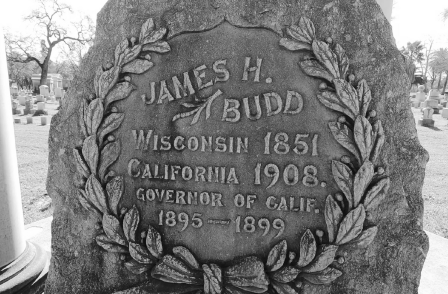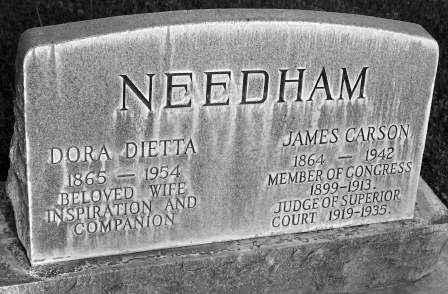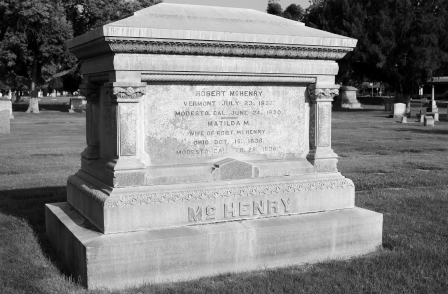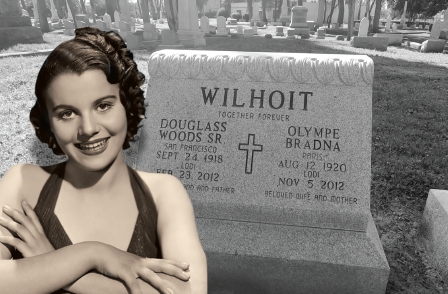Many people avoid cemeteries, but those fascinated by local history are intrigued to study the older burial grounds with their elaborate and unique markers and monuments and reflect on rich historical legacies.
Cemeteries throughout the 209 are a tangible link to local, state and national historical figures of decades and centuries ago.

Best known for killing Senator David Broderick in a San Francisco duel and meeting a violent death himself, California State Supreme Court Justice David Terry is buried there. The hot-tempered Terry became embittered against state Supreme Court Justice Stephen Field over a court decision. When the two showed up quite by coincidence at the Lathrop train station on Aug. 14, 1889, things got ugly fast. Terry interrupted Field’s breakfast and assaulted him. Field’s guard pulled out his gun and fatally shot Terry.
Underground film director Russ Meyer, whose grave marker notes he was “king of the nudies,” is at rest here. So is Hollywood actress Olympe Bradna Wilhoit (1920-2012) who starred in Ronald Reagan movies.

The conglomeration of cemeteries on Scenic Road in Modesto is replete with historical figures key to Stanislaus County. It’s the final resting place of Superior Court Judge Loren Fulkerth (1860-1934) who presided over the preliminary trial of outlaw Bill Dalton who was accused of robbing the train in Ceres on Sept. 3, 1891. Dalton and partner Riley Dean were released for a lack of evidence. Eventually the job was pinned on John Sontag and Chris Evans who engaged in bloody standoffs with the law. Deputy Marshal Andrew McGinnis, killed in a Fresno shootout with Sontag and Evans on Sept. 13, 1892, is buried at the Modesto Citizen’s Cemetery. The Knights Ferry resident and lawman was familiar with Sontag and Evans when they operated a livery stable in Modesto.
Meanwhile Dalton left California – but not for good – for Oklahoma. He participated in a May 23, 1894 bank robbery in Longview, Texas. Evidence at the scene led lawmen to his home near Pooleville, Okla., where he was shot and killed while attempting to flee. Dalton’s widow Jane Bliven Dalton brought his body back to Livingston to be buried in the yard of her father, Cyrus Bliven. When the house was sold, Dalton’s remains were relocated to an unmarked grave in Turlock Memorial Park.
Acacia Memorial Park in Modesto contains the remains of Lt. Harold “Bud” Coffee killed in a July 14, 1921 Modesto crash while making a historic flight from Yosemite Valley to the Bay Area. Also killed were three others, including Giocondo Jacuzzi whose brothers made the airplane prior to manufacturing whirlpools. Giocondo’s grave is a short distance away in the St. Stanislaus Catholic Cemetery.

One of the largest markers is that of notable Robert McHenry (1827-1890). Years ago, backed by DNA evidence, it was discovered that McHenry was actually Robert Brewster who changed his name after deserting the Army.
Another interesting Modesto grave is that of circus and old west sideshow performer Louis Fred Foster (1861-1924). His headstone, etched with “Rough and Fancy Rider & Roper, Rifle & Revolver Expert,” bears the likeness of a lariat he designed. Foster was acquainted with Buffalo Bill and Gordon “Pawnee Bill” Lillie. His photography side gig placed Sitting Bull before his lens. Foster was associated with Boston, Mass., but lived in Oakdale in his later years.
In Knights Ferry’s Oak Grove cemetery you’ll be greeted by a tall marker for William F. Lane, killed as a member of a posse tracking down horse thieves. The chase ended near the Coastal Range where Lane was fatally shot on April 21, 1858. Townsfolk avenged the death of his killer by breaking the suspect out of the jail in La Grange (then Stanislaus County’s seat) and lynched him from a tree.
The tallest grave marker in California is along Highway 140 east of Merced at N. Arboleda Drive. The lone grave is of George Hicks Fancher, an obscure farmer who died in 1900. He farmed 4,000 acres and became so wealthy that his estate designated $25,000 for his memorial. A more practical brother suggested a smaller marker and allocating $20,000 for a library in Merced. The matter was decided when a California State Supreme Court ruled that Fancher’s wishes had to be observed. He is buried under 1,000 tons of granite topped by a 68-foot-high obelisk jutting into the sky.
Mountain cemeteries

Tilted to the view of Highway 120 motorists, Jamestown’s hillside cemetery contains the remains of Donner Party survivor Leanna Donner App. She was one of the young daughters of George Donner when the famed immigrant party was trapped in a Truckee snowstorm the winter of 1846-47. The Donner children were rescued but their parents succumbed to starvation and exposure. Mrs. App was raised by foster parents. She died in 1930 and is laid next to husband John App, a Jamestown miner.
A number of graves in Calaveras County are linked to the infamous stagecoach bandit Charles Boles, AKA Black Bart who committed his first robbery at Funk Hill in Calaveras County on June 27, 1875. In his final robbery of Nov. 3, 1883 – committed at the same location – Boles was grazed by a bullet fired from the rifle of James “Jimmy” Rolleri who was deer hunting on the mountain when he stumbled upon the robbery. Rolleri died at age 37 and is buried in the Altaville Protestant Cemetery in Angels Camp. Boles was arrested days later in San Francisco and brought to San Andreas for trial in front of Judge Charles Victor Gottschalk who found him guilty and sent him to San Quentin State Prison.
Gottschalk was elected judge in Calaveras County in 1879 and served for 25 years. He married Charlotte Noriega, a woman 29 years his junior. The judge had grown fond of her sister’s son, Victor J. Shinn and when he died at age 10 on May 9 1898, Gottschalk grew despondent over the boy’s death. Feeling old and fearful that he was becoming a burden to his much younger wife, the judge shot himself in the head while sitting at his desk in the San Andreas courthouse. He is buried just feet from little Victor in the People’s Cemetery in San Andreas.
Jackson
Jackson City Cemetery (also known as Pioneer Cemetery) contains the remains of the victims of the August 27, 1922 Argonaut Mine disaster. Perishing in the fire and flood 4,650 feet below ground were 47 miners.

Angelo Noce (1847-1922), credited as being the father of Columbus Day, is buried in Jackson. An Italian immigrant who founded Colorado’s first Italian newspaper, Noce worked with a Colorado lawmaker to sponsor a 1906 bill proposing a Columbus Day holiday. Colorado created the holiday and the other states followed suit.
Also buried there is Hiram Craig Meek (1788-1881), a major in the War of 1812, who was acquainted with George Washington.
A link to President Lincoln may be found in the Ceres cemetery in the grave of George William “Will” Averill, an early-day blacksmith. Will served in the Civil War before heading to California and was assigned to the Army of the Potomac. During a nine-month hospital stay, Will met President Abraham Lincoln who sized him up and asked him to stand back-to-back to see who was taller; Will was two inches shorter than Abe. On another occasion, Mrs. Lincoln gave the ailing Will an orange.
Lakewood Memorial Park
Thousands of gravesites at Lakewood Memorial Park are the final resting place of many who lived their lives in Stanislaus County since the 1850s such as the pioneer Hudelson family. But others are more recognized. Hollywood actor Dean Jagger, best known for playing General Waverly in the timeless Christmas classic White Christmas and Major Harvey Stovall in the 1949 movie “Twelve O’Clock High,” was laid to rest in the North Hyland section of the Hughson cemetery near Santa Fe Avenue. He died in Santa Monica on Feb. 5, 1991 after succumbing to flu and a heart attack. Jagger became acquainted with Stanislaus County through his wife, 1941 Oakdale High School graduate and dance instructor Etta Mae Norton Jagger, who died in 1992 and is buried next to him.

Max Foster (1906-1996), founder of Foster Farms, rests at Lakewood. Foster was a Modesto Bee editor in 1939 when he and wife Verda purchased a repossessed 80-acre farm using $1,000 borrowed on a life insurance policy. They began raising turkeys and expanded to chickens and dairy cattle in the 1940s. Foster Farms is now the largest privately owned dairy and poultry business in California.
Chester Smith, an accomplished recording artist and TV station manager who died on Aug. 8, 2008, is also at Lakewood. Smith began singing on Modesto radio station KTRB in 1953 and signed a recording contract with Capitol Records where he achieved some fame with his hit, “Wait a Little Longer Please Jesus.” In 1963 he received a license for KLOC radio based in Ceres. Smith teamed up with Spanish International Network (SIN) which was the precursor to Univision.





